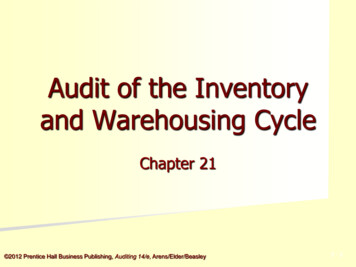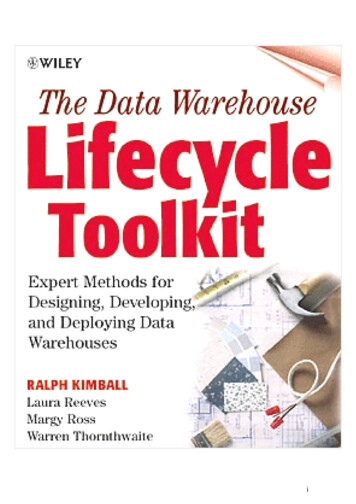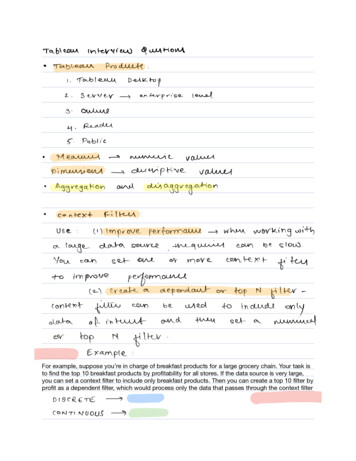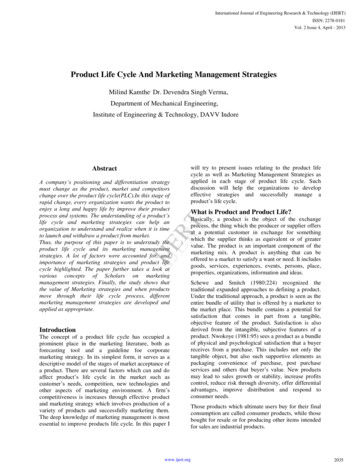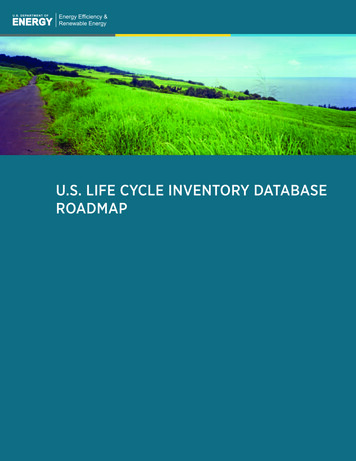
Transcription
rsedeU.S. LIFE CYCLE INVENTORY DATABASEROADMAP
Vision StatementThe U.S. Life Cycle Inventory Database will bethe recognized source of U.S.-based, quality,transparent life cycle inventory data and willbecome an integral part of the rapidlyexpanding use of life cycle assessment asan essential environmental analysisand decision-making tool.Goals of the U.S. LCI Database Project Maintain data quality and transparency. Cover commonly used materials, products, andprocesses in the United States with up-to-date,critically reviewed LCI data. Support the expanded use of LCA as anenvironmental decision-making tool. Maintain compatibility with international LCIdatabases. Provide exceptional data accessibility. Be fully and sustainably supported. Support U.S. industry competitiveness.
Executive SummaryWe make decisions concerning the environment everyday, and many of these decisions are based on incomplete, inconsistent, and flawed information. Life cycleassessment (LCA) provides a holistic evaluation methodology and a consistent framework for making betterinformed decisions. Life cycle inventory (LCI) data arethe primary inputs for conducting LCA studies. Studiesbased on high-quality data that are consistent, accurate,and relevant allow for robust, defensible, and meaningful results. The U.S. LCI Database (www.nrel.gov/lci) was initiated in 2003 to fulfill the need for publiclyavailable LCI data. The pro ject has been well received;however, it needs to be further developed and expandedto meet evolving and growing demands. Recent meetingsof interested parties have called for an increased effortto advance the database. A meeting of stakeholders onFebruary 18, 2009, in Washington, D.C., and an on-linesurvey were used as inputs in the development of thisroadmap.Participants noted that LCA is being used as input forpolicy decisions, corporate management, product development, marketing, environmentally preferable purchasing programs, and carbon or greenhouse gas reporting.Other areas that are expected to see expansion includebenchmarking for carbon trading, development ofenvironmental product declarations, end-of-life analysis,and global trade analysis. We will also likely see LCAmethods integrated with risk and social assessments,environmental externality studies, and geospatiallyfocused impact assessments. The use of LCA, and thusthe demand for LCI data, will likely continue to growrapidly as we search for comprehensive answers toenvironmental issues.We identified four critical paths: Project management Data management LCI data Communications.Three main themes overlie these paths: the need for highquality, transparent data; expansion of the database; andinternational compatibility. This roadmap explores thesethemes and presents a detailed two-year action plan andlong-range objectives to address these critical paths.Success of this project depends heavily on strong partnerships with industry, government, LCA professionals, andacademia. Communications will be essential tofoster these partnerships, and this roadmap is animportant part of the communications effort.Page 1
IntroductionThe drive toward sustainability and improved environmental decision-making is helping us recognizethe value of validated data about the environmentaloutcomes of our actions. Life cycle assessment (LCA)provides a holistic, science-based analysis methodfor decision-makers in all sectors concerning policies,product purchases, process performance, and education systems. The use of LCA for product and serviceanalysis is increasing and the demand for life cycleinventory (LCI) data is growing.The advantages of such a data source include: It provides comprehensive information for policymakers to make consistent comparisons betweenpolicy options regarding environmental decisions.Quality LCAs require quality LCI data, which arenot readily available. Often, LCA practitioners haveto develop their own data or modify data from othercountries for U.S. conditions. The assumptions andapproaches used by different practitioners can leadto variable results. Having consistent U.S.-based datais essential if we are to understand and manage theenvironmental impacts of U.S.-based processes.The U.S. LCI Database project began in 2001, whenthe U.S. Department of Energy (DOE) directed theNational Renewable Energy Laboratory (NREL) andthe Athena Institute to explore the development ofa national public database. The U.S. LCI Databasewas created and has been publicly available at www.nrel.gov/lci since 2003. The project strives to providepublicly available LCI data following a consistentprotocol, thus allowing users to objectively review andcompare data based on similar data collection andanalysis methods.What are we talking about?Life cycle assessment (LCA) is a holistic and systematicmethod for analyzing the environmental and human healthimpacts of a product or process across its life cycle. An LCAconsists of four steps:1.2.3.4.Define the goal and scope.Analyze the inventory (LCI).Assess the impacts (LCIA).Interpret the results.Life cycle inventory (LCI) is the accounting method usedto track the input and output material and energy flowsassociated with each step in a process or in the productionof a product. An LCA of a cardboard box, for example, mayinvolve linking dozens of LCI data sets to study the rawmaterials extraction, production, transportation, use, andrecycling or disposal life cycle stages.Life cycle impact assessment (LCIA) is the process ofdeveloping indicators of potential human and ecologicalimpacts from the LCI data.Page 2 It enables better evaluation of environmentalopportunities and trade-offs of alternative productsystems. Indirect sources of environmental impacts can beaddressed in the redesign of products for betteroverall environmental performance. Legitimate, verifiable environmental market claimscan be better substantiated based on quality LCIdata. Environmental hotspots can be identified andtargeted for improvement. It provides input to measure and monetize environmental externalities through, for example, acap-and-trade system.Several recent events have called for a renewed support and expansion of the U.S. LCI Database. TheCamp Long Declaration,1 drafted in October 2008,recognizes the growing demand for LCA and the needto support the U.S. LCI Database to become a comprehensive source of high-quality transparent datathat are compatible with international standards. TheNational Science and Technology Council Committeeon Technology called for “further development andmaintenance of the U.S. LCI Database.”2 OnFebruary 18, 2009, a stakeholders’ meeting was heldin Washington, D.C., to discuss the project and formulate a multi-year plan for expanding and refiningthe database. The plan represented in this documentwas developed with input from this meeting and froman on-line survey conducted prior to the n.pdfNational Science and Technology Council Committee on Technology(2008). Federal Research and Development Agenda for Net-Zero Energy,High-Performance Green Buildings www.ostp.gov/galleries/NSTC anceGreenBuildings.pdf
Drivers for the Need of a U.S. LCI DatabaseConsistent analysisNeed for U.S. dataDrive for sustainabilityLCA professional needsIndustrial interestEcolabels/marketingGovernment andcorporate policiesClimate change/carbonfootprintingGrowing U.S. interestLegislationrequiring LCA051015Number of Responses2025Drivers for Life Cycle Assessment andLife Cycle Inventory DataThe use of LCA is often driven by the demand forenvironmental accountability by customers, stakeholders, standards, and government regulations. Industryuses LCA for product development, marketing, andcorporate management and goal setting. Governmentmay use LCA for policy decisions and environmentallypreferable purchasing (EPP) programs. Environmentalproduct labels such as carbon footprints or completeenvironmental product declarations (EPDs) based onLCA are growing in use as voluntary applications—oreven as mandatory requirements. In an on-line survey,users indicated that sustainability, ecolabels, and climate change issues are major drivers for the increaseduse of LCA. Users also pointed out the need for aU.S.-based LCI database to provide for consistent andfair analysis of U.S. activities and data that are specificto U.S.-based life cycle impact assessment (LCIA).When the U.S. LCI Database was initiated, LCAactivity was limited to a small number of practitioners in consultant shops, large corporations, government, and academia. However, the demand for LCAhas grown tremendously in recent years, and morepractitioners use LCA to answer a wider variety ofquestions. More industries use LCA as a managementand environmental accounting tool. More regulationsrequire environmental accounting, and governmentEPP programs are expanding. LCA holds the promiseof providing consistent environmental performanceanalysis, and is a powerful tool to help answer complex questions.The more we use LCA, the more ways we think ofusing it, and the more LCI data we have available, themore uses we make possible. LCA is at the core of lifecycle management principles being incorporated bygovernment and businesses. Areas that are expectedto see expanded use of LCA include governmentpolicy making, EPDs, environmental performancebenchmarking, carbon trading, energy consumptionanalysis, and global trade analysis. LCA method ologyis rapidly evolving to incorporate new methods andareas of analysis. LCI databases need to grow andevolve to support and maintain compatibility withnew methods and tools.Vision of the Future —Where Do We Want To Be?The primary goal of the U.S. LCI Database projectis to provide publicly available, high-quality U.S.based LCI data that are comprehensive, transparent,and critically reviewed. Providing a database thathas transparent, quality-assured data is essential forsupporting quality LCA activity and for buildingcredibility and viability. Users consistently rank dataquality and transparency as two of the most important features of an LCI database. Users want confidence that the data are valid and demand a clearpicture of what they represent, where they came from,and their uncertainty. The database has to be largeenough to provide LCI data for most unit processesof commonly used energy sources, transportation,transformation processes, and materials.Page 3
Table 1. Critical PathsProject ManagementData Management Complete annualoperating plan. Define a data qualityprotocol. Establish advisoryboards. Revise data formats andprotocols. Develop a business plan. Complete databaseupdates. Partner with national andinternational efforts.Defining where we want to be allows us to plan howto best get there. With this in mind, we asked databaseusers to tell us the most important features of a publicLCI Database, and we have compiled the followingsuccess factors for a viable database: Transparent, high-quality LCI data Comprehensive coverage of commonly used materials, products, and processes Up-to-date, relevant data International compatibility High data accessibility Complete database documentation Efficient data submission and validation methods Broad support and participation from government,industry, and academia Sustained financial viability.Success Factors for the DatabaseFrom a User SurveyComprehensivedata tionalcompatibilityAccurate, current dataBroad support/useIndustry participationOngoing y usePage 4510152025Number of ResponsesCommunications Fill data gaps. Identify user needs. Expand the database. Develop acommunications plan. Maintain current data. Update Web site andproject documents.Critical pathsRealizing the vision for the database will require disciplined work and attention to critical paths for achieving our goals. We identified four critical paths withspecific tasks for each path (see Table 1).How do we get there?The U.S. LCI Database has already made progressalong many of these critical paths. A group of expertshas been working to help guide the project. We are incontact with international LCA and LCI data experts,and we will increase our role in promoting international LCI data exchange. Data quality plans are indevelopment and data gaps have been identified. Theuser survey and stakeholders’ meeting in Washington,D.C., have helped identify user needs and provideinput for this roadmap. Communications withstakeholders has been a central part of the projectfrom the beginning and will continue to be vital toits success.The next two years are seen as critical in advancingthe U.S. LCI Database and promoting it to the appropriate level of quality and completeness. We haveestablished an action plan for the next two years thataddresses the critical paths and will propel the database project to the forefront of LCA in the UnitedStates. In addition, we have laid out a long-rangemap that will guide our plans.Quality/credibility0LCI Data3035
Two-Year Action PlanSteps have already been takentoward the primary goal of providing a publicly available sourceof high-quality, transparent U.S.based LCI data. To achieve ourgoals, we have developed actionitems for the next two years (seeTable 2).Project managementThe foundation of a successful project is solid project management, and establishing themanagement team and advisoryboards is important to this process. The next steps will be tofully define the critical paths anddevelop a work plan to complete them. We will continueto strengthen and expand ourpartnerships with other groups tocomplete this work.A business plan will be developedand updated annually to guidedatabase management and helpplan staffing and budgets. Thisplan will define the managementstructure, including the formation and operation of an advisory board. The business planwill include the vision statement,objectives, and annual goals of thedatabase project. Various financialmodels for maintaining the pro ject, including alternative fundingmechanisms, will be explored.Table 2. Two-Year Plan for the U.S. LCI DatabaseAction ItemTimelineProject ManagementFully develop annual operating plans. *1–6 monthsFormally establish advisory boards.1–9 monthsPrepare requests for proposals and hiresubcontractors.1–9 monthsDevelop and implement a business plan. *3–12 monthsCoordinate with national and international LCA/LCIefforts. *1–24 monthsData ManagementDevelop a data quality control protocol and plan.1–12 monthsReview and revise data formats and protocols.1–12 monthsDevelop and implement a data reviewer qualificationplan.1–12 monthsImplement a data quality review program. *3–24 monthsExpansion/Revision of the DatabasePrioritize data needs.3–6 monthsFill data gaps.3–24 monthsReview and update or replace data sets. *3–24 monthsIncorporate new data from current LCA efforts. *3–24 monthsDatabase DevelopmentRevise database and data templates.3–12 monthsDevelop a data reviewing and tracking application.3–12 monthsDevelop applications for improved data accessibility.6–24 monthsDevelop streamlined data entry tools.12–24 monthsCommunicationsDevelop and Implement a communications plan. *3–24 monthsRevise and update the project Web site. *3–24 months*Activities that will continue beyond two yearsPage 5
Compatibility with international LCI databases isan important success factor, and we will increase ourcollaboration with international groups to harmonizeLCI data standards and promote data compatibility.This work is essential in light of growing global tradeand global environmental issues.Data managementCurrent database documents and tools will bereviewed, updated, and augmented to formulate anenhanced data management plan. Comprehensiveand consistent data and database protocols that follow International Organization for Standardizationrequirements and are compatible with recognizedinternational LCI efforts will form the foundationfor the plan. Levels of data quality and data validation procedures will be defined in coordination withinternational experts. Items to be included in the datamanagement plan are:Table 3. Data Updates by CategoryData CategoryActionEnergy and fuelsUpdate and expandTransportationUpdate and expandWaterNewTransformation processesExpandInfrastructureNewMetalsExpandPaper and paper productsNewGlassNewPlasticsExpandChemicals and mineralsExpandWood and wood productsExpandAgricultural and on of the databaseBuilding products andassembliesNewDatabase expansion is a primary objective of the pro ject and the subject of many user comments. We willexplore several avenues for expanding the database.Many data are available in the United States today,but would need to be provided or purchased and thenadapted to the U.S. LCI Database data format. In theimmediate future, we will work with several groups torevise their data for inclusion in the U.S. LCI Database. Some data may be purchased and solicitationsfor these data and will be developed and sent out forproposals. Data priorities are based on initial databaseplanning exercises, survey results, and the February2009 stakeholders’ meeting. (See Table 3.)TextilesNewEnd of lifeNew Database functional, formatting, nomenclature,and documentation requirements Data quality control protocol Coordination with LCIA efforts Data publication and updating procedures Arbitration rules for settling disputes.Database developmentThe current database contains LCI data for unitprocesses and some gate-to-gate processes. Userscan browse through the data sets by category, viewindividual data sets online, and download single datasets or the entire database. New search-and-viewapplications will be added, which will be essential asthe database grows. New applications will be exploredPage 6to improve data accessibility and usability. An application will be developed to streamline submission,review, and tracking of new data to the database.CommunicationsAn effective communications program is crucial tomaintaining user and stakeholder support. Communications with users will ensure that the data are beingused correctly and that we receive feedback about dataquality and database usability. Partnerships betweenthe database project managers, data suppliers, datausers, end users, and supporters are critical for keeping the database up-to-date and relevant. Severalcommunication avenues such as newsletters, Web siteupdates, user forums, educational materials, technical publications, conference presentations, conferencecalls, and Web meetings will be employed.
Long-Range PlanTable 4. Long-Term ObjectivesMaintaining the database as an up-to-date source ofcredible LCI data and achieving all the project goalswill require a sustained effort. It will require supportand input from several groups to keep the effort flourishing. Maintaining its long-term financial viabilitywill be the biggest challenge and will require exploringalternative models and flexibility in operations. Wehave laid out several long-term objectives to guide thesuccessful continuation of the database (see Table 4).Project ManagementNext StepsPeriodically review data formats and protocols.As we search for better answers for solving today’schallenging environment issues, we need to have theproper data and analysis systems in place. LCA offersa structured methodology for looking at the issues,and quality LCI data provide the starting point forthe analysis. We are committed to making the U.S.LCI Database a leader in quality, completeness, andtransparency. This roadmap provides a path towardthat vision. It will take a continued effort and attention to detail, but the result will be better informationfor improved environmental decision making.NREL and DOE will work with their partners toimplement the steps laid out
Life cycle assessment (LCA) is a holistic and systematic . . cycle management principles being incorporated by government and businesses. Areas that are expected to see expanded use of LCA include government . Realizing the



